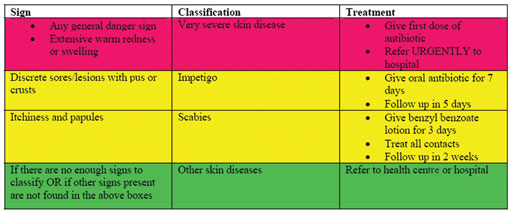13.4.2 Classify and treat skin infections
After assessing the child for skin infections, the next step is to use all your findings so that you can classify the skin condition as shown in Table 13.6 reproduced from the Assess and Classify chart.
Table 13.6 Classify and treat skin infections.
Impetigo
Impetigo is common among preschool children and young adults as well. Impetigo begins as a single reddish tiny swelling containing fluid that progresses to one or many honey-coloured, crusted lesions weeping fluid. Impetigo most frequently occurs on the face, around the nose and mouth, and on the extremities. It is associated with increased risk of kidney disease and it should be treated by giving the child amoxicillin for seven days. Follow-up care should be provided five days after the initial classification.
Scabies
Scabies is characterised by severe itching. It is caused by small mites that burrow under the skin, and is transmitted by close contact the infected person. Itching is intense, particularly during the night.
Vesicles distributed in the web spaces of fingers, wrist, elbows, umbilical area, genital area and feet are often seen. Usually the face and neck are not affected.
Vesicles: small swellings on the skin containing clear fluid. Scabies is described in more detail in Study Session 39 of Communicable Diseases, Part 4.
Children with scabies should be treated with an application of 25% benzyl benzoate lotion daily to the whole body below the neck. The solution should be left on for 13 hours and should then be washed off. The treatment should continue for three days. All family members and close contacts of the child should be treated simultaneously, as scabies is very contagious. Follow-up care should be provided within two weeks of the initial classification.
In this study session you have learned about common problems in children, most of which may not appear to cause risk of immediate death. However, as you have seen, diseases of the ears, throat, eyes and skin can give rise to serious medical problems that may lead to death or to disability. Therefore your role in early identification of problems and providing the appropriate treatment and follow-up care is very important.
13.4.1 Assess skin infections

